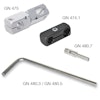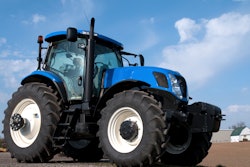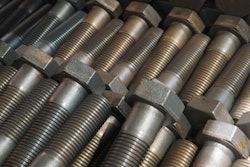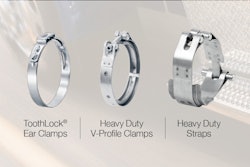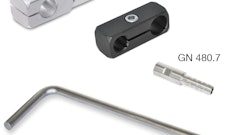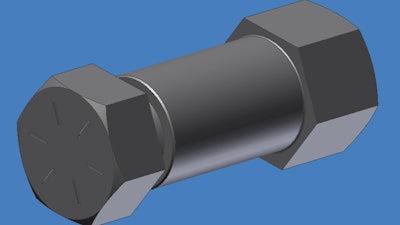
In any type of heavy-duty off-road vehicle, such as construction, agricultural, or mining, there can be severe consequences if critical fasteners loosen or fail during operation. If this occurs, it not only affects the function of the equipment and causes substantial production downtime and costs for repair, but for the operator and anyone nearby it can be potentially life threatening, especially when large loads are carried.
Yet the critical fasteners in such vehicles can fail when subjected to vibration, shock, dynamic loading or thermal stress. Vibration of heavy equipment during operation is one of the main causes of fastener self-loosening. In fact, it can be a particular problem for any heavy-duty off-road vehicle utilizing a diesel engine to move or carry large loads or do other strenuous work for long periods of time.
The vibration causes the side sliding of the nut or bolt head relative to the joint, resulting in related motion occurring in the threads. The gradual rotation causes a bolted joint to lose its preload (the initial fastener tension when tightened) and subsequently leads to fastener loosening.
Any shock or jolt to such vehicles, such as when travelling over bumpy, uneven terrain and receiving or dropping loads can also cause bolt threads to slip relative to joint threads, which can prompt bolt loosening.
Similarly, dynamic loading due to digging, threshing, or any other strenuous work – particularly over many thousands of cycles over years – can cause fastener loosening via slippage relative to the joint threads, culminating in device failure as well.
Thermal stress caused by cyclical changes in temperature, due to hot environments or continual use, can also contribute to loosening. With any mismatch between the thermal expansions of the bolt and joint, expansion induced radial shear stress can weaken the friction torques and cause bolted joints to loosen.
Although many OEMs view fasteners as commodity items, for heavy-duty off-road vehicles the conditions demand superior solutions to prevent fasteners from loosening. In vehicle assembly alone, approximately two-thirds of the parts and half the labor are related to fastening in one way or another. So, applying the wrong type of fastener can have a negative impact on assembly costs, warranties, sales, liability and even the overall brand image.
 Fastener loosening or failures can cause major performance issues in heavy-duty off-road equipment.Multi Piece Fastener
Fastener loosening or failures can cause major performance issues in heavy-duty off-road equipment.Multi Piece Fastener
Solutions to prevent loosening
OEMs have long used a variety of fastener designs that attempt to stop bolted joint loosening through the use of adhesives or added components that physically restrain the bolt or nut from loosening. However, these methods have significant drawbacks.
Locking adhesives attempt to hold fasteners in place once tightened, yet the adhesives progressively lose effectiveness as temperature rises. Bolts secured with a single use, dry patch adhesive that is activated when the bolts are tightened also add to assembly costs. With both options, if the item is to be removed and re-used the threads must be cleaned first at great cost in time and labor.
With mechanical locking approaches, the goal is to physically prevent loosening. However, this often means adding components that increase the size of the fastener and add weight and complexity to component design. For large off-road vehicles, heavier fasteners are a drawback. Smaller and lighter fasteners, when used throughout the vehicle, can potentially increase work or load capacity along with fuel efficiency.
However, a new approach which physically prevents vehicular bolt loosening without the traditional limitations of excess weight, complexity and length is available in the market. The fastener design, called ForeverLok™, involves three items: a central threaded fastener, a threaded intermediate fastener and a retaining fastener.
Essentially, the fastener system holds the nut in place to physically prevent it from loosening. Although there are competitive products on the market that work in a similar fashion, this design is more compact than the traditional nut and bolt configuration. The locking design does not use special pins, bolts or tools to install or remove the nut, and only common tools are needed to fasten or unfasten.
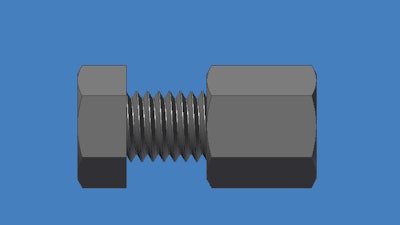 The design of the ForeverLok allows the fastener to be smaller, lighter, and more compact while providing comparable torque value to a larger fastener.Multi Piece Fastener
The design of the ForeverLok allows the fastener to be smaller, lighter, and more compact while providing comparable torque value to a larger fastener.Multi Piece Fastener
The design allows the fastener to be smaller, lighter, and more compact than a larger fastener while providing a comparable torque value. For example, the torque value of a 1/2-in. (1.3 cm) fastener design tested greater than the recommended torque value of a 5/8-in. (1.6 cm) bolt.
In addition, the fastener design is reusable as many times as needed. The fasteners can be made of many materials such as titanium, steel and other metals/alloys. The design also works just as well for plastic fasteners when weight or cost is a prime consideration. The technology, which is available for licensing, is flexible enough for a manufacturer to create their own unique new product based upon it.
The effectiveness of the ForeverLok approach has already been put to the test in three of the most rigorous anti-vibration tests.
In a maximum torque test, involving a 1/2-in. grade eight bolt, the design tested at 159.9 ft/lb. (216.8 Nm), a 77% increase over the 90 ft/lb. (122 Nm) of torque recommended for a standard 1/2-in. bolt. The higher torque value allows OEMs and design engineers to use a lighter, smaller fastener to save space and weight.
The design was also tested against the NASM 1312-7 standard, which involves accelerated vibration testing on a fastener system capable of providing a clamp-up load. In the test, the bolt/nut combination is installed in the fixture, and the fixture is subjected to controlled vibration and cycles/times until the assembly loosens. For this test, the fastener must not be able to be loosened by hand after 30,000 cycles, approximately 17 minutes of testing.
Testing of the ForeverLok design, however, was suspended after over 420,000 cycles and 4 hours of testing with no loss of torque retention. NASM 1312-7 does not require the residual torque value to be reported. However, the testing facility provided the measurement: the fastener design retained 93.5% of its original torque value.
Against the tougher transverse vibration standard, DIN 25201-4, the design torque retention test results were 89.43%, clearly surpassing the certification standard which requires 80% retention or higher. This standard involves testing the fastener 12 times. The less strenuous DIN 65151 tests the fastener to a less exacting setup and verification standard, testing it once.
Although traditional locking fastener systems are available, OEMs and engineers searching for solutions to critical fastener loosening will find that considering a new design approach can result in lighter, simpler, more reliable fasteners in heavy-duty off-road vehicles.
 Smaller, lighter fasteners are beneficial for heavy-duty equipment as they can help to improve load capacity.Multi Piece Fastener
Smaller, lighter fasteners are beneficial for heavy-duty equipment as they can help to improve load capacity.Multi Piece Fastener
This article was contributed by Multi Piece Fastener L.L.C. It was written by Del Williams on behalf of the company.

